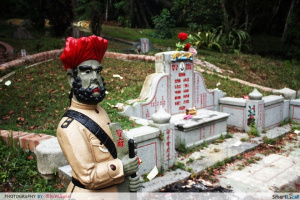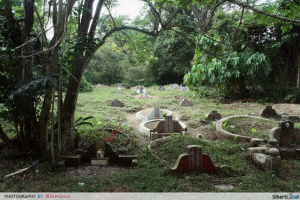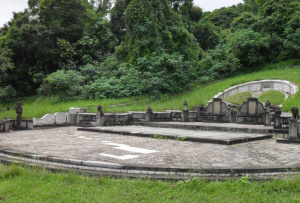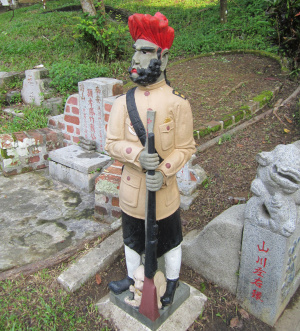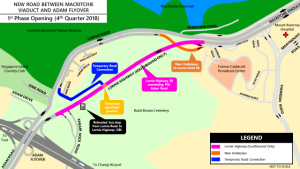Bukit Brown Cemetery
Bukit Brown Cemetery initially named Seh Ong cemetery, was owned by 3 wealthy Hokkien brothers belonging to the Ong clan.[1] From 1872 to 1921, the cemetery was reserved for members of the clan until it was converted to a municipal burial ground. The cemetery stopped taking in burials in 1973. In recent years, there has been a revival of interest in Bukit Brown Cemetery due to the development plans of Lornie Highway in 2013 that led to the exhumation of graves in the cemetery. In 2014, Bukit Brown was one of the heritage sites listed on the World Monuments Watch List.[2]
History
Bukit Brown Cemetery was named after a British merchant and shipowner by the name of George Henry Brown in the 1840s.[3] The land was owned by the merchant and named as such by British map-makers. Following George Henry Brown's relocation to Penang, the land was handed over to the Seh Ong and Huay Kuan clan.[4] In the 1870s, the land became a burial ground solely for the family members of the clans.[5] Ong Kew Ho, Ong Ewe Hai and Ong Chong Chew were in charge of the administration of the cemetery.[6]
In January 1922, Bukit Brown Cemetery was opened as a Municipal burial ground for the Chinese public having been bought over by the British colonial government. Faced with a shortage of land for burial purposes, the British government considered several sites for the public municipal burial ground.[7]
During a Municipal Commission statement in October 1918, it was stated that the original owners of Bukit Brown Cemetery petitioned against the government's decision to open the grounds for public Chinese burial.[8] However, the land was eventually ceded to the government using the Land Acquisitions Act. Based on a newspaper report from August 1921, the cemetery was broadly divided into "general" and "pauper" sections.[9] According to the Municipal By-laws for the burial ground, it cost $15 at the time to bury an individual in the "general" section while it was free for those who opted for the "pauper" section.[10]
The cemetery had around 100,000 tombs on site in 1973. In a bid to solve the issue of land constraint, the Singapore government closed Bukit Brown Cemetery in 1973.[11]
Prominent tombs
In Bukit Brown Cemetery, there are individuals who have bought plots of burial land for their entire family. In the 1921 Municipal By-laws, such a plot of land would have cost $50 at the time.[12] The largest reported tomb in the cemetery belongs to Ong Sam Leong and his family. Its size is approximately the same as 10 three-room HDB flats.[13]
Ong Sam Leong was the President of Bun Chye Ho Club, reportedly the oldest Chinese club in Singapore in 1918.[14] He headed his own firm, Ong Sam Leong and Co. that dealt in the timber, oil and rubber industries.[15] He was buried in the then Seh Ong cemetery in 1918.[16] When his wife passed away in 1935 at the age of 73 years old, New World amusement park was closed as a show of respect.[17] Her sons, Ong Boon Tat and Ong Peng Hock were the proprietors for the amusement park.
Other notable figures that were buried here include Tan Ean Kiam, the Managing Director of OCBC (Oversea-Chinese Banking Corporation)[18] and Chew Boon Lay, whose legacy lives on in the names of Boon Lay MRT station and housing estate.[19] Gan Eng Seng, who established Anglo-Chinese Free School and had a school named after him, was also buried in Bukit Brown Cemetery in 1899.[20] Lee Hoon Leong, grandfather of the late Prime Minister Lee Kuan Yew, had been buried at Bukit Brown Cemetery as well.
Tomb design features
The tombs in Bukit Brown Cemetery are diverse. Certain features such as the design, engraving and statues differ according to the deceased's religion, culture, and family preference. For example, tombs that were tiled belonged to Peranakan individuals who used them as decoration for their homes.[21]
It is also a common sight to see statues of guards, most common Sikh guards, placed beside tombs.[22] There are reportedly around 30 of these statues throughout the cemetery placed by the wealthy to guard their tombs. The design and layout of the tombs also differ according to Chinese dialect groups.[23]
Lornie Highway and infrastructure developments
Lornie Highway, also known as Bukit Brown Road, is a dual four-lane road that was constructed to reduce congestion between Lornie Road and the Pan-Island Expressway (PIE).[24] Construction was supposed to have taken place from early 2013 to 2016. However, it had gone through multiple delays and the first phase of Lornie Highway was only opened on 28 October 2018.[25] The Bukit Brown burial grounds have also long been bookmarked as a potential site for residential housing.[26]
When the Land Transport Authority (LTA) first notified the public about their plans for the new road, they had estimated about 5% of the more than 100,000 graves to be affected. However, after further planning, it was announced that the number of graves affected had been reduced.[27] The Land Transport Authority (LTA) implemented exhumation works that started towards the end of 2013.[28] Exhumed remains that were unclaimed by family members 3 years after the exhumation works were to be scattered at sea.
Public response
Many nature and heritage groups objected to the plans for Lornie Highway as it would have to cut across the forested Bukit Brown area and cemetery where many notable Singapore pioneers are buried.[29] These individuals viewed the cemetery as a site of Singapore heritage. Some also expressed that if the route planning had been done more efficiently, the removal of such a large number of graves would not be necessary and the numbers could have been further reduced.[30]
Tours
In lieu of the development plans, groups like All Things Bukit Brown (official website) have conducted walking guided tours of the cemetery. These regular guided tours happened at a fixed timeslot every first weekend of the month and were led by volunteers.[31]
Another initiative called the 'Bukit Brown Wayfinder trail' had been released by the Singapore Heritage Society (SHS) on 18 November 2017. The project was a self-guided trail of a certain part of the cemetery. The trail contains informative content such as detailed signs, write-ups of significant tombs and explanations of the rites and rituals practised at the cemetery.[32] The Bukit Brown Wayfinder booklet is also available online for reading (Bukit Brown Wayfinder PDF).
References / Citations
- ↑ Chong, Terence and Chua Ai Lin. "The Multiple Spaces of Bukit Brown" in Public Space in Urban Asia (2014), p. 28.
- ↑ "Bukit Brown Cemetery: 2014 World Monuments Watch". World Monuments Fund. Accessed on 27 April 2019. Retrieved from: https://www.wmf.org/project/bukit-brown
- ↑ Huang Jianli. "Resurgent Spirits of Civil Society Activism: Rediscovering the Bukit Cemetery in Singapore", The Malaysian Branch of the Royal Asiatic Society 87 (December 2014): 21 - 45.
- ↑ Huang Jianli. "Resurgent Spirits of Civil Society Activism: Rediscovering the Bukit Cemetery in Singapore", The Malaysian Branch of the Royal Asiatic Society 87 (December 2014): 21 - 45.
- ↑ Huang Jianli. "Resurgent Spirits of Civil Society Activism: Rediscovering the Bukit Cemetery in Singapore", The Malaysian Branch of the Royal Asiatic Society 87 (December 2014): 21 - 45.
- ↑ Chong, Terence and Chua Ai Lin. "The Multiple Spaces of Bukit Brown" in Public Space in Urban Asia (2014), p. 28.
- ↑ "Municipal Commission". Malaya Tribune. October 27, 1917. Retrieved from NewspaperSG.
- ↑ "THE INFLUENZA OUTBREAK". The Singapore Free Press and Mercantile Advertiser. October 26, 1918. Retrieved from NewspaperSG.
- ↑ "CHINESE BURIAL GROUND". Malaya Tribune. March 30, 1921. Retrieved from NewspaperSG.
- ↑ "CHINESE BURIAL GROUND". Malaya Tribune. March 30, 1921. Retrieved from NewspaperSG.
- ↑ "Timeline of a grave saga". The Straits Times. June 13, 2011. Retrieved from NewspaperSG.
- ↑ "CHINESE BURIAL GROUND". Malaya Tribune. March 30, 1921. Retrieved from NewspaperSG.
- ↑ "Ong Sam Leong, A Grand Repose". bukitbrown.com. February 9, 2012. Accessed on 27 May 2019. Retrieved from: http://bukitbrown.com/main/?p=1185
- ↑ "LATE MR ONG SAM LEONG". The Singapore Free Press and Mercantile Adviser. February 8, 1918. Retrieved from NewspaperSG.
- ↑ "LATE MR ONG SAM LEONG". The Singapore Free Press and Mercantile Adviser. February 8, 1918. Retrieved from NewspaperSG.
- ↑ "Untitled". Malaya Tribune. February 26, 1918. Retrieved from NewspaperSG.
- ↑ "DEATH OF MRS. ONG SAM LEONG". Sunday Tribune (Singapore). May 26, 1935. Retrieved from NewspaperSG.
- ↑ "Mr. Tan Ean Kiam. the managing director of the Oversea-Chinese Banking Corporation, Ltd." Malaya Tribune. May 26, 1934. Retrieved from NewspaperSG.
- ↑ "FNERAL ANNOUNCEMENT". The Straits Times. June 6, 1933. Retrieved from NewspaperSG.
- ↑ "DEATH OF MR. GAN ENG SENG.". The Singapore Free Press and Mercantile Advertiser (Weekly). September 14, 1899. Retrieved from NewspaperSG.
- ↑ "BUKIT BROWN WAYFINDER: A SELF-GUIDED WALKING TRAIL". Singapore Heritage Society, p. 40.
- ↑ "BUKIT BROWN WAYFINDER: A SELF-GUIDED WALKING TRAIL". Singapore Heritage Society, p. 76, 96 - 97.
- ↑ "BUKIT BROWN WAYFINDER: A SELF-GUIDED WALKING TRAIL". Singapore Heritage Society, p. 15.
- ↑ "Construction of new dual four-lane road to relieve congestion along PIE & Lornie Road and serve future developments." Land Transport Authority. September 12, 2011. Accessed 16 January 2019. Retrieved from: https://www.lta.gov.sg/apps/news/page.aspx?c=2&id=rj2i4o1u3d7018466v86y82epxjj32mwbvnhu6rpwt8lplkgo6
- ↑ Tan, Christopher. "First phase of Lornie Highway, also known as Bukit Brown Road, to open on Oct 28". The Straits Times. October 11, 2018. Accessed on 16 January 2019. Retrieved from: https://www.straitstimes.com/singapore/transport/first-phase-of-lornie-highway-also-known-as-bukit-brown-road-to-open-oct-28
- ↑ Siau Ming En. "Exhumation of Bukit Brown graves to start in Oct". TODAY. August 6, 2013. Accessed on 27 May 2019. Retrieved from: https://www.todayonline.com/singapore/exhumation-bukit-brown-graves-start-oct
- ↑ "LTA finalises alignment of new road across Bukit Brown". Land Transport Authority. March 19, 2012. Accessed on 16 January 2019. Retrieved from: https://www.lta.gov.sg/apps/news/page.aspx?c=2&id=3409b41og5bkgr1vr0asqb8vmgzeso0ghnwn0212451i6dxwk8
- ↑ Chua, Grace. "Recommended by Exhumation at Bukit Brown Cemetery begins". The Straits Times. December 19, 2013. Accessed on 16 January 2019. Retrieved from: https://www.straitstimes.com/singapore/exhumation-at-bukit-brown-cemetery-begins
- ↑ Tan, Christopher. "First phase of Lornie Highway, also known as Bukit Brown Road, to open on Oct 28". The Straits Times. October 11, 2018. Accessed on 16 January 2019. Retrieved from: https://www.straitstimes.com/singapore/transport/first-phase-of-lornie-highway-also-known-as-bukit-brown-road-to-open-oct-28
- ↑ Jagdish, Bharati. "Too much heritage affected by roads and MRT lines: Architect, historian Lai Chee Kien". Channel News Asia. Updated April 29, 2018. Accessed on 16 January 2019. Retrieved from: https://www.channelnewsasia.com/news/singapore/lai-chee-kien-architect-historian-on-the-record-10181678
- ↑ "First Weekend of Every Month : Regular Guided Walks". All Things Bukit Brown. May 24, 2015. Accessed 16 January 2019. Retrieved from: http://bukitbrown.com/main/?p=9864v
- ↑ Hio, Lester. " New Bukit Brown Cemetery self-guided trail takes visitors through 25 tombs". The Straits Times. November 18, 2017. Accessed 16 January 2019. Retrieved from: https://www.straitstimes.com/singapore/new-bukit-brown-cemetery-self-guided-trail-takes-visitors-through-25-tombs
